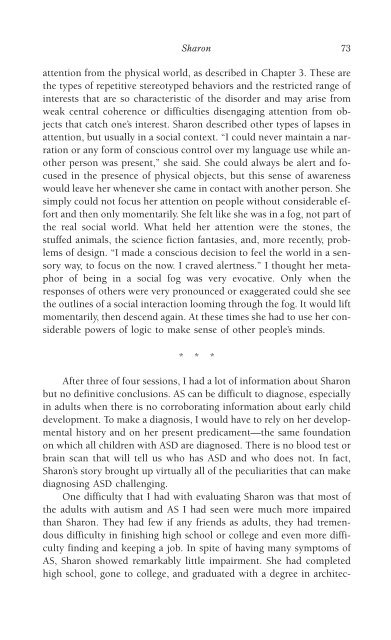978-1572305441
autism
autism
Create successful ePaper yourself
Turn your PDF publications into a flip-book with our unique Google optimized e-Paper software.
Sharon 73<br />
attention from the physical world, as described in Chapter 3. These are<br />
the types of repetitive stereotyped behaviors and the restricted range of<br />
interests that are so characteristic of the disorder and may arise from<br />
weak central coherence or difficulties disengaging attention from objects<br />
that catch one’s interest. Sharon described other types of lapses in<br />
attention, but usually in a social context. “I could never maintain a narration<br />
or any form of conscious control over my language use while another<br />
person was present,” she said. She could always be alert and focused<br />
in the presence of physical objects, but this sense of awareness<br />
would leave her whenever she came in contact with another person. She<br />
simply could not focus her attention on people without considerable effort<br />
and then only momentarily. She felt like she was in a fog, not part of<br />
the real social world. What held her attention were the stones, the<br />
stuffed animals, the science fiction fantasies, and, more recently, problems<br />
of design. “I made a conscious decision to feel the world in a sensory<br />
way, to focus on the now. I craved alertness.” I thought her metaphor<br />
of being in a social fog was very evocative. Only when the<br />
responses of others were very pronounced or exaggerated could she see<br />
the outlines of a social interaction looming through the fog. It would lift<br />
momentarily, then descend again. At these times she had to use her considerable<br />
powers of logic to make sense of other people’s minds.<br />
* * *<br />
After three of four sessions, I had a lot of information about Sharon<br />
but no definitive conclusions. AS can be difficult to diagnose, especially<br />
in adults when there is no corroborating information about early child<br />
development. To make a diagnosis, I would have to rely on her developmental<br />
history and on her present predicament—the same foundation<br />
on which all children with ASD are diagnosed. There is no blood test or<br />
brain scan that will tell us who has ASD and who does not. In fact,<br />
Sharon’s story brought up virtually all of the peculiarities that can make<br />
diagnosing ASD challenging.<br />
One difficulty that I had with evaluating Sharon was that most of<br />
the adults with autism and AS I had seen were much more impaired<br />
than Sharon. They had few if any friends as adults, they had tremendous<br />
difficulty in finishing high school or college and even more difficulty<br />
finding and keeping a job. In spite of having many symptoms of<br />
AS, Sharon showed remarkably little impairment. She had completed<br />
high school, gone to college, and graduated with a degree in architec-



